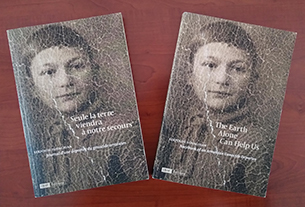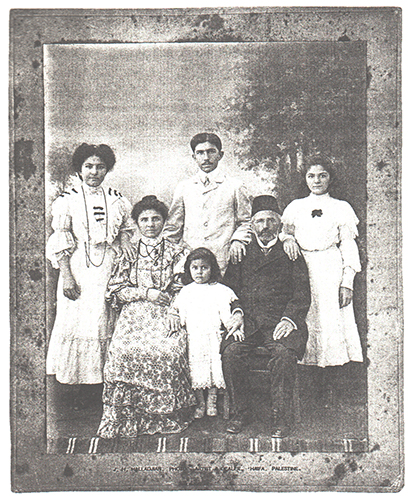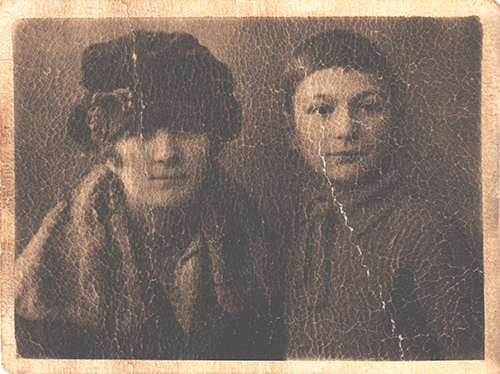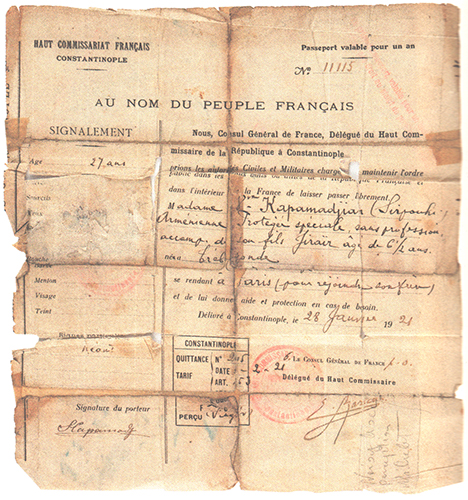
The French National Library published an English and French diary-memoir in April of this year titled "The Earth Alone Can Help Us" written by Srbuhi Hovakyan, who, by the narrowest margin, survived Armenian Genocide. It was edited by Raymond Kevorkian and Maximilian Girard. The presentation of the book took place at the National Library of France on May 11, during which Raymond Kevorkian, Maximilian Girard and Annie Roman, Srbuhi's granddaughter, gave introductory speeches.
Srbuhi Hovakyan's memoir is unique because it was written during the days of the Ottoman Empire's genocide against the Armenians. Eyewitness accounts describe the events of 1915-1918.
She is one of the few Armenians who survived one of the most horrific episodes of the Armenian Genocide, the Kemakh gorge massacre. The memoir starts in Armenian and continues in French. There are also Greek passages in it. The book also contains photocopies of family documents and photographs.
The author, Srbuhi, was born in Trabzon in 1893. Her father, Hakob, worked for a railway construction company that was building a railway from Constantinople to Baghdad and into Palestine. That was why the Hovakyan family lived mainly in Palestine and Baghdad until Hakob Hovakyan's death in 1906. It was during these years that Srbuhi learned brilliant French. Srbuhi returned to Trabzon with her mother, Ani Khachaturyan, her brother Gurgen and her two sisters, Vaskanush and Vardanush, after the death of her father.
Srbuhi married Garnik Kapamajyan, a tobacconist from Trabzon, in 1909. He often went to Europe on business. Srbuhi stayed with her family in Trabzon until the unfortunate year of 1915.
When the deportation of Armenians from Trabzon began in June 1915, Srbuhi and her family migrated to Yerznka (Erzinjan). Her husband hurried back from Europe to Trabzon but was arrested and killed a few days later.
Overcoming many difficulties, 22-year-old Srbuhi escaped from the guards accompanying the deportees, who had already reached the shores of the Black Sea at Kirason. Before that she had been separated from her four-year-old son Jirayr. She also lost her daughter, Aida, on the road to exile, whom she never found. Then, constantly changing places to stay, she led an underground life in Trabzon and Kirason, always keeping a diary, where she recorded her experiences and eyewitness testimony.
This is what Srbuhi wrote on the way to Yerznka (Erzinjan):
“We walked for 6 hours a day, hungry and thirsty, for no purpose. To walk and walk along a road until you end your life is an indescribable torment… The Euphrates River always flowed past us, and we waited for them to throw us into the river at any moment. They took two carts carrying little boys and threw them into the river. Oh, what a horrible scene that was; I can still see it before my eyes and is always in my mind and I don’t think it ever disappear. When I saw those boys’ bodies in the water and that their limbs were still moving, I was shocked, and I was even more horrified when I saw those monsters watching them with ironic smiles. Oh my God, my only prayer is to see these poor boys avenged”.
Srbuhi started actively looking for her son after the Mudros armistice. Her uncle, who lived in Russia, helped her. He found out that the American Relief Committee for the Middle East had rescued many Armenian and Greek orphans from Trabzon, who had reached Georgia with Russian troops. Carrying the wedding photo sent to him by Srbuhi in his hand, he went to the orphanages, trying to find his cousin. Seeing the photo, little Jirayr, who was in the Batumi orphanage, recognized his parents. Years later, mother and son, both of who had miraculously survived, met each other.
In 1921 the French High Commissioner in Constantinople gave Srbuhi a passport so she could move to France with her son, where she continued living.
The National Centre for Armenian Memoirs in Lyon, France organised an exhibition in 2018 titled "Srbuhi Hovakyan's Odyssey".
Srbuhi Hovakyan’s memoir titled "My Armenian Grandmother" was published in Armenian and French by her granddaughter Annie Roman in 2019.
The Armenian Genocide Museum-Institute would like to thank the National Library of France for this very important publication, highlighting the role of memoirs in the study and work of dissemination of information about the Armenian Genocide.
It should be noted that the AGMI has initiated the creation of a series of books of unpublished memoirs of Armenian Genocide survivors kept in its collections, within the framework of which the first four books were published last year. Several more are planned to be published this year.
 The Hovakyan family. Ani and Hakob Hovakyan sitting in the centre, with their youngest daughter Vardanush in the middle, their other children Vaskanush, Gurgen and Srbuhi standing on the left.
The Hovakyan family. Ani and Hakob Hovakyan sitting in the centre, with their youngest daughter Vardanush in the middle, their other children Vaskanush, Gurgen and Srbuhi standing on the left.
 Srbuhi Hovakyan with her son Jirayr.
Srbuhi Hovakyan with her son Jirayr.
 Passport issued to Srbuhi Hovakyan by the French High Commission in Constantinople, January 28, 1921.
Passport issued to Srbuhi Hovakyan by the French High Commission in Constantinople, January 28, 1921.





